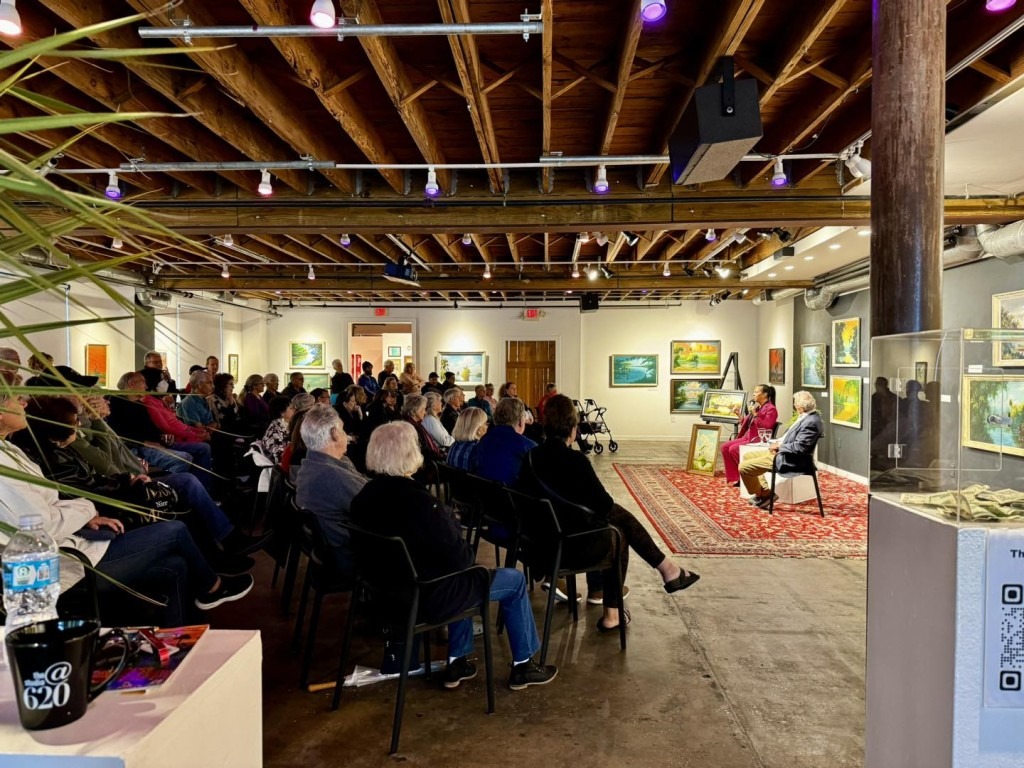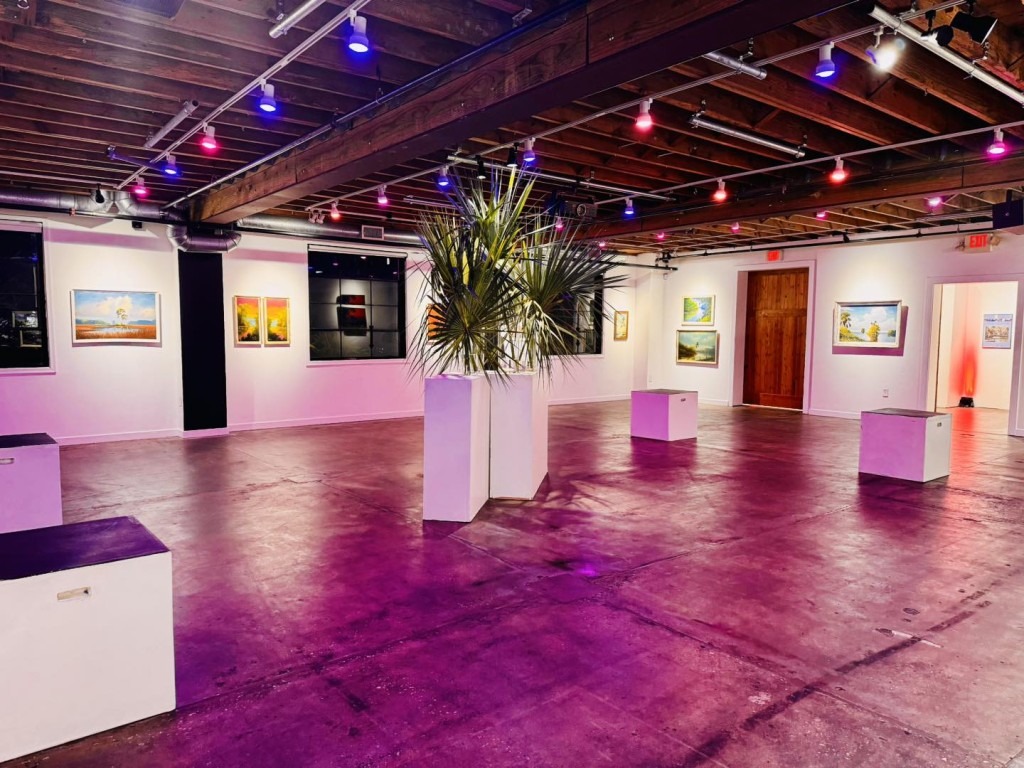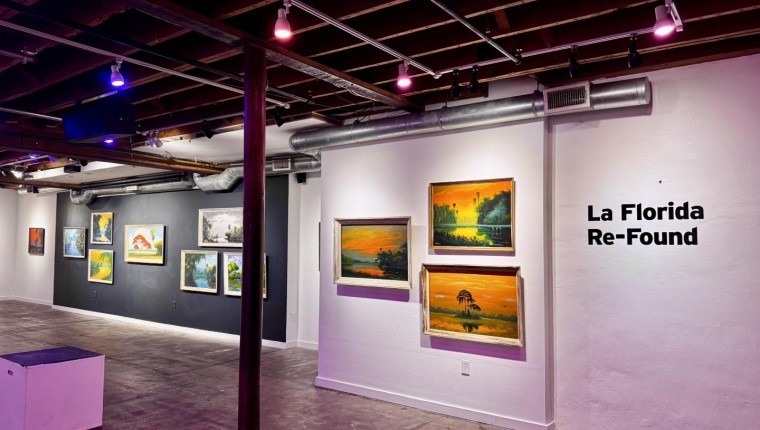La Florida, Re-found
. .
The Highwaymen returned to The Studio@620 in downtown St. Pete this month — or at least their spirits did, thanks to a staged reading of a play written and directed by Bob Devin Jones called Further Down the Road.
It wasn’t the first time Further Down the Road had been presented at The Studio. Devin Jones wrote the play, which was about the now famous Black artists dubbed The Florida Highwaymen who sold their paintings by the side of the road in the ’50s, nearly two decades ago.
He wrote it when Canadian art collector Tony Hayton first brought his Highwaymen paintings to the St. Petersburg cultural venue for an exhibit called Further Down the Road. Held in 2005, just a few months after The Studio@620 first opened its doors, the play had its debut at that exhibit.
This month Hayton returned to The Studio with his collection for an exhibit dubbed The Florida Highwaymen: La Florida, Re-Found. In the 19 years between the two exhibits, The Highwaymen have become a lot more famous and the value of their paintings – which originally sold for $25 or $30 a canvas – have skyrocketed, some to six figures.
To celebrate the current show, Devin Jones dug up Further Down the Road, to see if it still held up. Back in 2005, it was described as “a play dealing with the racial climate during the late 1950s and 1960s in which the Highwaymen painted and sold their work. It will be set in the city of Ft. Pierce, the home of the Highwaymen.”
“I hadn’t thought about that play in 19 years,” said Devin Jones.
On February 22 five young Black actors — Aaron McQuarter, Lance Felton, Edward Leonard, Alex Joustra and Joshua Dupree — took to the stage to perform the second staged reading of Further Down the Road. Behind them were Hayton’s Highwaymen paintings, Florida landscapes conjured up long ago by the very characters the actors were bringing to life.

A bright red Poinciana tree dominated a canvas right behind the actors. A golden orange and yellow sky reflected in the water in another. In rehearsals, Devin Jones asked the actors to tour the gallery slowly, stopping before each painting, picking out the one that spoke to them in particular.
As I listened these actors, who were giving voice to artists who for so long had remained without a voice, the Highwaymen materialized before my eyes, as vivid as those landscapes behind them.
Collector Hayton, who was present at the reading, talked about his passion for collecting Highwaymen paintings. Living in Ottawa, he saw his first ones online, he told us, and he was thunderstruck. He had never seen such illuminating paintings. Who were these artists, he asked himself, who had painted these haunting scenes of Florida with palette knives thick with paint?
Researching online, Hayton discovered that the backstory of these artists was as compelling as their artwork. The creators of these works of real and imaginary Florida scenes painted on gypsum boards set off by molded wooden frames were African American artists who had worked together in the late 1950s near Fort Pierce.

This was rural Florida at the time of Jim Crow segregation, but instead of “planting, picking, and packing,” these 25 Black men and one woman made a living off painting the land.
Barred by racism from showing their work in whites-only galleries, they sold their work directly to white businesses and – yes, out of the trunks of their cars – to mostly white tourists traveling on A1A and US1.
They called themselves “Colorists.”
It wasn’t until the 1990s that they became known as The Highwaymen, a moniker coined by entrepreneur Jim Fitch who along with St. Petersburg Times reporter Jeff Klinkenberg brought the story of The Florida Highwaymen to a larger public. The name stuck.
Hayton calls the group “the last great American art movement of the 20th century.” The number of paintings the Highwaymen (and one Highwaywoman) eventually produced are estimated between 250,000 and 400,000.
After that first glimpse online, Hayton bought up as many of these landscapes as he could find, scooping up 35 works unseen in a single online sale. Finally collecting 80 original Highwaymen paintings, he then made it his mission to spread the word about this remarkable art movement by exhibiting these “real and the imagined landscapes of Florida with colors and forms that captured the raw energy of the land” across North America. The 2005 exhibit at The Studio@620 was one of his first.
Here’s how The Studio described the work for that first Further Down the Road exhibit – “Drawing on their own cultural heritage they abandoned the formal academic approach to representation and instead took from their own deep interior landscape a unique creative energy. They used this energy to construct a mythology of images that have the ability to touch everyone who sees them.”

The first scene of Devin Jones’ Further Down the Road is set in 1970, right after the funeral for Albert Hair, one of the original catalysts of the group who had just been murdered in a bar.
The second scene takes us back to the 1950s when Hair (played by Alex Joustra) was first teaching these artists to paint, creating an assembly line system which allowed them to finish up to 20 paintings a day – with one artist painting the trees, Spanish mosses or wild orchids, another the shimmering rivers and lakes while another tackled the skies exploding with color.
Throughout the play, I felt like I was like eavesdropping on intimate banter among friends who were speaking in a shorthand language only possible among those who are intimately linked by a common cause
They argued about who was grieving most over the loss of their mentor. They shared their successes and failures at finishing up a canvas. They complained about a fellow Highwayman who was catting around instead of showing up for work.
And in the final confrontation between Alfred Hair and Harold Newton, the other Highwaymen artist who is credited with spearheading the movement, they wrangled over the very definition of an artist.
Newton (played by Edward Leonard) told Hair that he didn’t want to have anything to do with those collectively painted works organized by Hair (who enjoyed his Cadillac and the other material pleasures he bought with the steady income they received from the works). Newton wanted to paint his own canvas and sign his own name to those paintings, not join an assembly line.
Hair and Newton were the only Highwaymen with any formal art training. While still a teenager, Hair took a few art lessons from A.E. Backus, the white dean of Florida landscape painting, who offered classes for 50 cents a lesson to children in the Fort Pierce area. Backus also mentored Newton when he was a teen, urging him to start doing landscapes instead of the religious scenes he was painting.
Today a Highwaymen painting that sells in the six figures is usually one signed by Newton or Hair.
How did Bob Devin Jones create such realistic dialogue for these characters, an audience member asked during the question-and-answer exchange that followed the reading. “Research!” he quickly replied — although he admitted that there actually was very little biographical material about these artists available. So to fill in, he reached into his own experiences growing up, basing the characters on his own uncles. Doesn’t every family, after all, have an Uncle Alfred or an Uncle Howard with quirky personalities we know only too well?
The Studio@620 exhibit of the Highwaymen works from the Hayton collection closes on March 2. Through June, however, you can see 23 original Highwaymen paintings from the collection of Roger Lightle at Sarasota’s City Hall. Lightle, who is the owner of Highwaymen Art Specialists, Inc. in Vero Beach, has been collecting since the late 1990s. He owns approximately 700 Highwaymen paintings.
Eight of the original 25 Highwaymen are still alive, most of them still painting, including. . .
– Roy McLendon (born in 1932) “often branched out beyond traditional Highwaymen scenes of beaches and landscapes. His depiction of figures and narrative scenes – neighbors hanging laundry or a mother and child on their way to go fishing, for example – set McLendon’s work apart.”
Sam Newton (born in 1948), “hyper, with a lot of talent,” Rodney Demps told The Highwaymen Trail. “’He’d fry fish and paint at the same time. And his paintings were superior.’” Newton is “noted for his expert use of color, and realistic, rather than impressionistic, technique”
Al Black (born in 1947), started as a salesman for the Highwaymen group, and grew into a fellow artist. “He could sell a jacket to a mosquito in summer,” his contemporary and fellow Highwaymen painter Pastor Mary Ann Carroll told NPR in a 2012 interview.
Willie Reagan (born in 1939), “As a formally trained artist his work is technically astute and much sought after.” After Hair’s death, Reagan taught art to middle and high schoolers in Vero Beach for more than 20 years, returning to painting after his retirement.
R.L. Lewis (born in 1941), “I was forced into an art class due to a football injury that prevented my participation in physical education,” Lewis told the Ocala Star Banner in 2010. “My teacher (Alberta Leisure) gave me motivation to continue a pursuit of fine arts.”
“I use color to display the mood I am experiencing. Bright colors make the meaning clear. Often, I am focused on there being so many people who are spiritually or emotionally dead and not even aware of it. I want to wake them up.”
During his career, Lewis worked as an illustrator for Boeing, and taught in the Brevard County school district for 32 years.
Sylvester Wells (born in 1938), whose “early work focused on Floridian sunsets, waving palms, colorful skies, and crashing ocean scenes. But he did later begin depicting scenes of everyday life happening within his landscapes.” Cracker-style Cabin is now part of the permanent collection of the National Museum of African American History and Culture.
Charles Walker (born in 1945), communicates “the details he observed in Florida’s landscapes, especially in terms of wildlife. The beautifully depicted turkeys and animals that typically inhabit his paintings are. . . a characteristic which sets him apart” from other Highwaymen.
and Curtis Arnett (born in 1950), “With drawing and painting at the center of his creative life since early childhood, Arnett has attributed a watercolor set he received from his mother for Christmas at the age of seven as the beginning of his exploration of painting. The paints brought his earliest subjects – Lois Lane, Clark Kent, and other favorite pop culture figures of the day – to life on scraps of cardboard and other materials he could scavenge easily.” He sold his first Highwaymen landscape at age 16, as his work evolved “into the more sophisticated renderings of the Florida interior, swamps, and seascapes he is known for today.”
Other painters in the movement, in addition to Alfred Hair (1941-1970) and Harold Newton (1934-1994) were. . .
– Hezekiah Baker (1940-2007), “We improvised from something in our mind,” Hezekiah Baker told the New York Times
– Ellis Buckner (1943-1991), “took his studies as a painter seriously, and devoted hours to learning technique and perfecting his rendering of depth and perspective.” His paintings “stand apart in their use of subdued or, perhaps, more realistic color palettes and photographic attention to detail in the water and skies.”
– George Buckner (1942-2002), “Today considered one of the most technically accomplished Highwaymen painters, his work stands out among that of his contemporaries in both its exquisite detail and precise execution. He is especially renowned for his skies and clouds, and the ‘shimmering’ quality of his landscapes.”
– Robert Butler (1943-2014), “I was swimming in this fantastic psychological soup at the time; I came from this poor background and yet this door was opening wide for me, to this universe that could be explored forever.”
– Mary Ann Carroll (1940-2019), “Known for her intense use of color, especially in her trademark Poinciana trees, the subject of Carroll’s work firmly focused on scenes of Florida’s natural beauty, including its seascapes and sunsets.”
“A drawing of a thermometer she’d done in a science class became her ‘first art exhibition,’ when her impressed teacher tacked it up on the bulletin board.” Former First Lady Michelle Obama is a fan, and Carroll’s work is in the National Museum of African American History and Culture’s permanent collection.
– Johnny Daniels (1954-2009), ” The youngest of the original 26 Florida Highwaymen painters,” Daniels started out making frames for the Highwaymen, before learning to paint from them. “Daniels’ paintings are known for his use of a palette knife to create thick applications of paint and a contrast of warm yellows, reds, and oranges against cooler tones of blues and whites. Often depicting birds, bears, and fish,” he’s known for “detailed rendering of lush foliage and dreamy skies.'”
– Willie Daniels (1950-2021), ” Skilled in brushwork as well as working with a palette knife, his work is noted for its traditional Highwaymen scenes rendered in his own impressionistic style, and for its eerie and dreamlike nightscapes.”
– Rodney Demps (1953-2020), ” Known as “the surrealist Highwayman,” Rodney Demps’s “early landscape paintings show a strong influence by Hair, infused with his own more painterly approach and an air of surrealism in their light and movement.”
– James Gibson (1938-2017), “Painting fast – once he painted 100 paintings in a day to win a bet with Hair – Gibson was a savvy businessman and learned what was popular and sold best, paying attention to décor he encountered on the road and even, according the The Highwaymen Trail, calling carpet factories to learn which colors were selling best.
Author Gary Moore told the TC Palm, “(Gibson’s) early work was vernacular painting that fitted in with (customers’) wants and needs. It was raw, primitive and real.”
– Isaac Knight (1941-2022), “Knight’s early works depicted typical Highwaymen Florida tableaux of ocean and landscapes, and he always painted from memory, as most of the Highwaymen did.
“In his later years, Knight worked almost entirely in black and white, enjoying the tones and shadows the pallet of blacks, greys and whites allowed him to play with as a painter, much as photographers do with black and white film.
– John Maynor (1948-2076), “Maynor’s individual style often featured a textured rendering of trees using thick layers of paint applied with a palette knife, as well as an application of linseed oil to give his water scenes a sense of shimmer and movement.”
Also a commercial artist, “Maynor’s signs have advertised businesses in and around Fort Pierce for decades.”
– Alphonso Moran (1930-2003), “Of all the Florida Highwaymen painters, perhaps the least is known about Alphonso ‘Poncho’ Moran,” apparently because he earned more “wowing spectators and opponents alike with his skills at the pool table.”
“His skill as a painter is clear in the few confirmed Moran works available, demonstrating he favored the use of bold colors typical to the Highwaymen and had a technical affinity for developing his canvases in layers of thickly applied paint. Unusual among the Highwaymen, Moran occasionally also incorporated people into his scenes.”
– Lemuel Newton (1950-2014), 16 years younger than his more famous brother, Harold Newton, Lemuel Newton “was a careful painter who cared about the quality of his work. He painted typical Highwaymen scenes of flame trees, swamps, palms, beaches, and sunsets with great attention to detail, and was adept with utilizing warm and inviting color palettes in his work.”
– Livingston Roberts (1942-2004), “known as “Castro” to his friends for his Fidel Castro-like beard, was one of the earliest Florida Highwaymen painters to join artists Alfred Hair and Harold Newton in painting and selling their works along Florida’s highways.”
“He was the best painter of all the Highwaymen, and the nicest,” said Al Black. “Whenever I needed inspiration, I would go over to Castro’s backyard to watch him paint,” Highwaymen artist James Gibson said at Roberts’s memorial.
– Carnell Smith (1950-2015), “Carnell Smith’s work features Poinciana and palm trees and is known for its generally upbeat and optimistic renderings of the Sunshine State.”
“Smith attended the Lincoln Park Academy where his teacher Zanobia Jefferson introduced him to painting, as she did for several of the Highwaymen painters. When his older sister Dorothea married Alfred Hair, the artist credited with organizing the Fort Pierce group of Highwaymen artists, Smith moved in with the couple and began learning from Hair.”
“Eventually, he and Dorothea began painting Hair’s backgrounds and skies when demand for Hair’s work soared and he needed to increase production. . . It wasn’t until after Hair was shot and killed in 1970 that Smith began painting his own work. . .”
– and Charles Wheeler (1946-2019). “In his earliest days as a Highwayman, Wheeler worked on building frames for the group and learned painting by watching, as many of the new artists under Hair did.”
Much of Wheeler’s work was “unique in its depictions of everyday life within the scenes he painted. According to The Highwaymen Trail, Wheeler painted ‘figures that pick oranges, hang laundry, fish, and walk down dirt roads. His landscapes and seascapes are dreamy and colorful, often sporting vibrant skies. He also paints animals: deer, dogs, cows, and birds. His landscapes are more ‘lived in’ than most other Highwaymen paintings.'”
In 2004, all 26 of the Highwaymen were inducted into the Florida Artists Hall of Fame.
You can take a virtual tour of The Highwaymen Heritage Trail
created by the City of Fort Pierce FL and Florida Humanities



